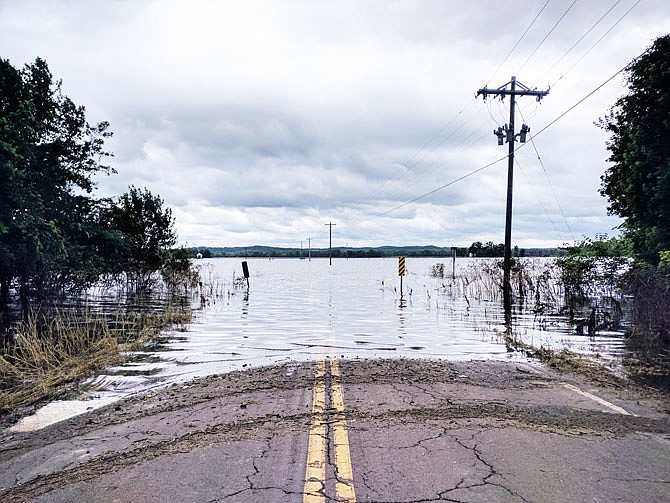Tebbetts farmer Peggy Smart's corn is feeding the fishes.
"About 90 percent of our crop land is underwater, or it has been," she said Wednesday. "Some of it has gone down, but it's not anywhere near to the point we can get on it to farm it."
A drive through the normally rich and green bottomlands near Callaway County's southern border reveals soggy fields and standing water. Smart's family has been farming 4,000 acres along the Missouri River - from near Jefferson City all the way to Steedman - longer than many Callawegians have been alive.
Smart Brothers Farms, and other Callaway County riverbottom farms, have weathered weather disasters before.
"That's just the life of a riverbottom farmer," Smart said.
She remembers 1993, the all-time record flood for the Missouri River, when she and her husband had to build their own levee to keep the water out of their house. Further back, in 1973, a lesser flood dumped a load of sand on their farmland.
"We ploughed it under, but we can't do that again because it'll just bring the sand back up," she said. "Sometimes after a flood, you get good soil, topsoil that covers the property that came from someone else's farm somewhere."
However, the one-two punch of the Chinese tariffs driving down the price of soybeans along with destroyed or diminished crops may make this a particularly hard season for farmers.
This time around, the floods arrived shortly after planting.
"We had some corn planted and we had a few soybeans planted," Smart said. "Some of them are still out of the water but not a whole lot. Most of the corn we had planted, the river destroyed it."
She said if the water recedes fast enough and the damage to the land isn't too severe, she might be able to replant some of those acres. But that's a lot of "ifs."
"We don't know what the damage is going to be yet, because we can't get to the levees to see if they were breached or just overtopped," Smart said. "If they were overtopped, it'll take a while to recede, because we'll have to pump it out. There might be some higher ground we can get into. We'll plant what we can by the first week in July. After that, it's pretty iffy."
Farmers like Smart across the Midwest are juggling tough decisions about whether to take crop insurance payouts or take a gamble on planting soybeans.
Flood troubles
According to the USDA's June 17 crop progress report, Missouri's farmers are behind in planting corn and soybeans, the state's top crops. Typically by June 16, 99 percent of all corn acreage has been planted; by June 16 this year, 89 percent had.
The soybean situation is even worse. Only 57 percent of soybean acres were planted as of June 16. During the last five years, an average of four in five acres - 81 percent - have been planted by this point in the season.
Farmers in Iowa have seen similar difficulties, also triggered by the flooding Missouri River. Damage to Iowa's economy could top $2 billion, according to the Iowa Farm Bureau. A senior economist with the Farm Bureau estimated 145,000 acres of farmland were flooded, the Des Moines Register reported.
The current disaster follows floods farther west, where some 1 million acres of farmland were under water across nine states at the end of March, according to Reuters.
It's not yet clear how flooding will impact corn and soybean prices. Following the Flood of 1993, reduced crop production led to a spike in prices for corn and soybeans, according to the Federal Reserve Bank of St. Louis. Early signs point to prices following suit this year. During a three-week period ending June 6, prices for corn and soybeans went up 8.5 and 21.4 percent, respectively.
However, a report in Farmdoc Daily by agricultural economics professors pointed out that tariffs in China have depressed soybean prices. Prices could also drop if more producers switch from corn to soybeans due to late planting conditions.
Even if prices stay high, that's only good news for the farmers who actually succeed in producing crops.
Luckily, there are resources to help Callaway County farmers who have been affected by this spring's severe weather.
The U.S. Department of Agriculture's Farm Service Agency offers a number of programs designed to help farmers recover from losses.
"FSA has a variety of disaster assistance programs to support farmers and ranchers through times of adversity," said Brent Hampy, state executive director for the FSA in Missouri. "Once you are able to evaluate your losses, it is important to contact your local FSA office to report all damages and losses and learn more about how we can assist."
A five-step online quiz will help producers determine which USDA disaster assistance programs will meet their needs at farmers.gov/recover/disaster-assistance-tool. The Callaway County Farm Service Agency can be contacted at 573-592-1400.
In the meantime, local farmers hope the flood is on its way out and recovery can begin.
"But with the way the rains have been and the reservoirs up above having to dump with the snow melt and heavy rains. It's kind of a nightmare. For some reason, we're making that man upstairs angry. We better straighten out," Smart joked grimly.

